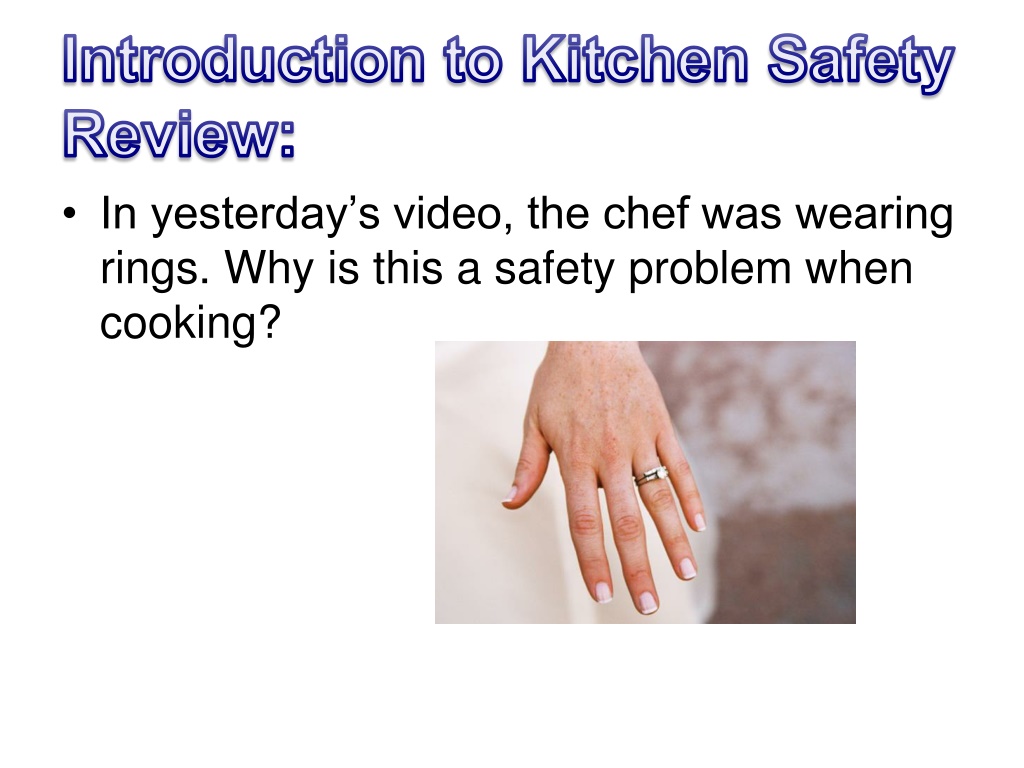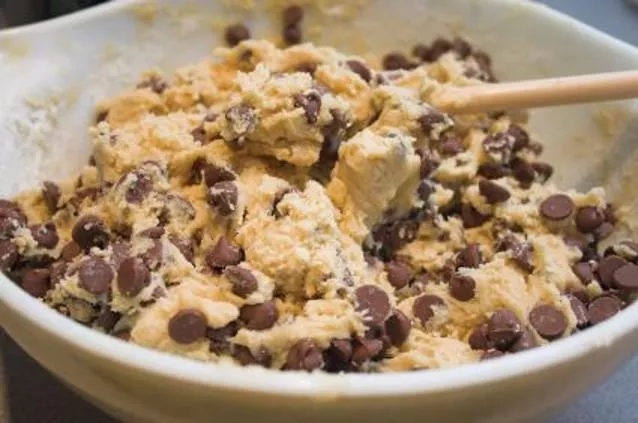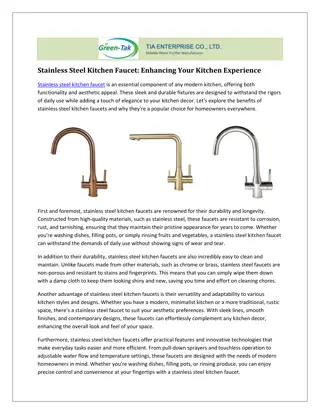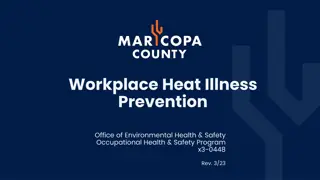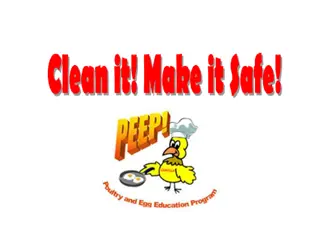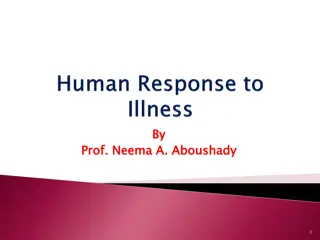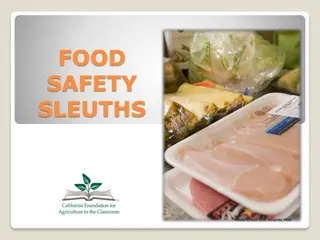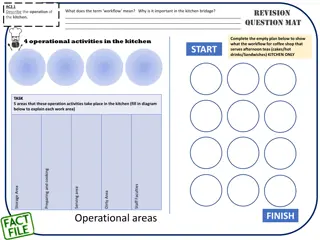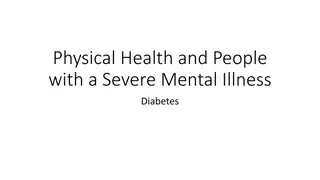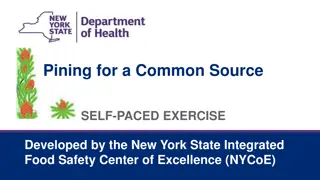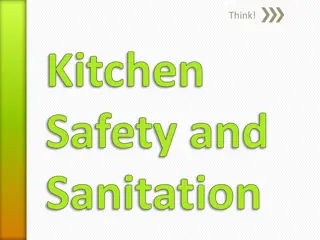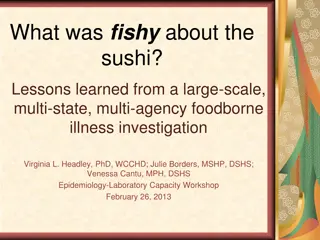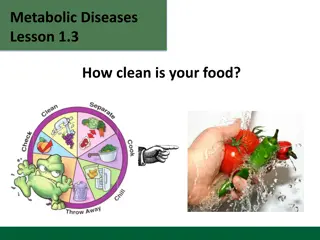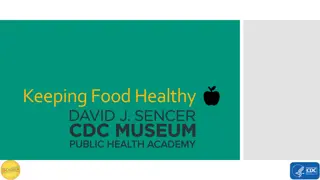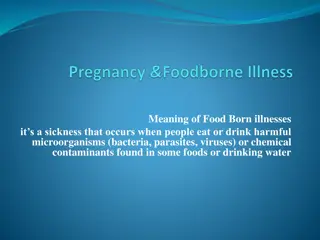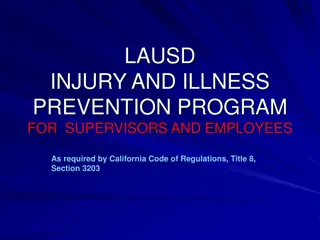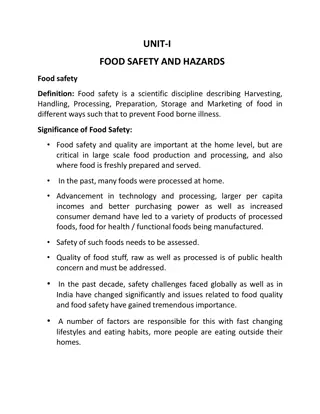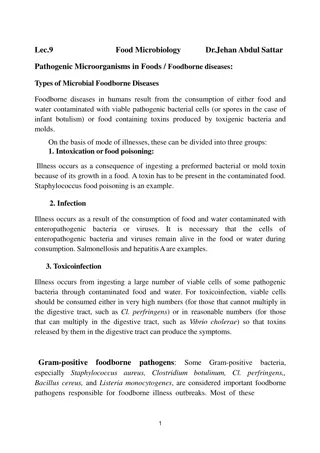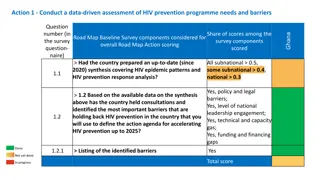Importance of Kitchen Safety and Foodborne Illness Prevention
Understanding the significance of kitchen safety and foodborne illness prevention is crucial to maintaining a safe and sanitary cooking environment. This overview delves into the risks associated with improper practices, such as wearing jewelry while cooking, consuming raw cookie dough, and the potential hazards of foodborne pathogens. Additionally, it outlines common foodborne illnesses, symptoms, and ways to mitigate risks through proper food handling, hygiene, and sanitation practices.
Download Presentation

Please find below an Image/Link to download the presentation.
The content on the website is provided AS IS for your information and personal use only. It may not be sold, licensed, or shared on other websites without obtaining consent from the author. Download presentation by click this link. If you encounter any issues during the download, it is possible that the publisher has removed the file from their server.
E N D
Presentation Transcript
Introduction to Kitchen Safety Review: In yesterday s video, the chef was wearing rings. Why is this a safety problem when cooking? https://s.yimg.com/os/287/2012/02/29/93586899-jpg_205402.jpg
Pre Heat Question How many of you eat raw cookie dough or taste your cake batter? http://wac.450f.edgecastcdn.net/80450F/mychannel957.com/files/2011/11/Cookie-Dough.jpg
Cooking Safety and Sanitation Ms. Makuta
Objectives: Define foodborne illness/foodborne pathogens. Explore the various ways of contracting foodborne illness. Identify common foodborne illnesses contracted during cooking.
Why is food safety important? From food borne illness each year: 1 and 6 Americans (or 48 million people) will get sick,128,000 people will be hospitalized, and 3,000 will die of foodborne diseases CDC. MPj04393330000[1] Reducing foodborne illness by just 10% would keep 5 million Americans from getting sick each year. Preventing a single fatal case of E. Coli would save an estimated $7 million.
What is foodborne illness? Food Borne Illness: Is a disease carried or transmitted to people by food. Food borne illnesses are infections or irritations of the gastrointestinal (GI) tract caused by food or beverages that contain harmful bacteria, parasites, viruses, or chemicals. Common symptoms of food borne illnesses include vomiting, diarrhea, abdominal pain, fever, and chills
What is foodborne illness? Food Based Hazards Contaminated ingredients Biological Chemical Physical People Based Hazards Food handling Time & Temp abuse Cross contamination Poor hygiene Improper cleaning & Sanitizing Who's at Risk Pregnant women Elderly Babies Individuals with chronic illnesses
Common Foodborne Microorganisms Salmonella: bacteria found on raw uncooked poultry, seafood, diary products, and eggs. Listerosis: bacteria found on deli - ready to eat meats and other highly processed goods. Listerosis Botulism: bacteria found in improperly canned can goods, or other air tight food items. Hepatitis A Hepatitis A: Virus found in human feces and can contaminate any food a human touches. Staphylococcus: Found on humans in high concentrations under fingernails and in the nostrils of up to 25% of healthy people.
Common Foodborne Microorganisms Trichinosis: Ringworm like parasite found primarily in pork caused by animals eating other animals. Yeast: Fungus known to appear pink and/or bubble especially in bad sour cream, jelly, or foods that contain sugar. E Coli Ecoli: Bacteria found primarily in beef and unpasteurized products. Shigellosis: Bacteria found in salads and sandwiches that involve a lot of hand contact in their preparation, and raw vegetables contaminated in the field. Shigellosis
Fight Bac How many germs are on your hands right now? http://ts1.mm.bing.net/th?id=H.4539996331705772pid=15.1
Fight Bac How many germs are on your cell phone? Does any one want to guess?
Pre Heat Question Is it sanitary to wash your chicken prior to cooking? No, raw chicken and turkey can carry bacteria on their surfaces, research has shown that washing raw poultry under running water in your kitchens ink is a bad idea. If germs were visible to the naked eye, you would see that washing poultry just splashes bacteria all over you, your kitchen towels, countertops, and any other food you have nearby, such as raw foods or salads. Instead, just take raw poultry straight from the package into the cooking pan. The heat from the cooking process will kill any bacteria that are present. Then simply clean up any splashes and wash your hands with soap and hot water.
https://sp2.yimg.com/ib/th?id=HN.607995931472235954pid=15.1P=0https://sp2.yimg.com/ib/th?id=HN.607995931472235954pid=15.1P=0 Oh no, I m sick Doug: Last night: Doug decided to try the new deli with his friend Paul. Doug and Paul both ordered hot Italian subs. Today: Doug texts Paul from the bathroom where he has sent most of his evening. Paul replies that he has had similar evening. Their symptoms: diarrhea, vomiting, fever Two days later: Doug and Paul are feeling better, back to school, and are 5 pounds lighter. What do you think happened to Doug and Paul? Justify your response.
Least Wanted Foodborne Pathogen salmonella listeria coli Salmonella The most common cause of foodborne deaths. Sources: raw and undercooked eggs, undercooked poultry and meat, fresh fruits and vegetables, and unpasteurized dairy products. Listeriosis A serious disease for pregnant women, newborns, and adults with a weakened immune system. Sources: unpasteurized dairy products, including soft cheeses; sliced deli meats; smoked fish; hot dogs; pate'; and deli-prepared salads (i.e. egg, ham, seafood, and chicken salads). E. Coli A bacteria that can produce a deadly toxin. U.S. Sources: beef, especially undercooked or raw hamburger; produce; raw milk; and unpasteurized juices and ciders.
Least Wanted Foodborne Pathogen staph shigella Staphylococcus Shigella A bacteria that produces a toxin that causes vomiting shortly after being ingested. Sources: cooked foods high in protein (e.g. cooked ham, salads, bakery products, dairy products) that are held too long at room temperature. Causes an estimated 448,000 cases of diarrhea illnesses per year. Poor hygiene causes Shigella to be easily passed from person to person and from infected individuals to food items. Sources: salads, unclean water, and any food handled by someone who is infected with the bacterium.
Potentially Hazardous Foods PHF: Support rapid growth of microorganisms Every 20 minutes bacteria double Foods have naturally occurring bacteria living on them that are there to break down the food. Can anyone give an example? There are a list of characteristics of PHF s that you can remember by the acronym FAT TOM
FAT TOM F: Food Animal origin foods that are raw or heat treated Plant origin foods that are heat treated A: Acidity 4.6-7.5 ideal for bacteria growth High acidity neutralizes the bacteria Acid will eat the protein T: Temperature 40 F or colder 140 F or hotter T: Time Food can be in the danger zone for a maximum of 4 hours before becoming hazardous O: Oxygen Allows bacteria to grow Wrap food products tightly to eliminate exposure to oxygen M: Moisture Bacteria need moisture to grow
Danger Zone Definition: The temperatures at which bacteria multiply rapidly. When is the food cooked safe? Poultry and Stuffing: 165 F Pork: 145 F Beef, Lamb and Seafood: 145 F Rare Beef: 135 F Hamburger (ground beef): 155 F 140 F Danger Zone 40 F
Sanitation Check: The acronym FAT TOM stands for what F A T T O M
Cross Contamination Definition: The transferring of bacteria from person or object to another. Lather Up Always wash hands, cutting boards, dishes, and utensils with hot, soapy water after they come in contact with raw meat, poultry, and seafood. Safely Separate Separate raw meat, poultry, and seafood from other foods in your grocery shopping cart and in your refrigerator. Seal It To prevent juices from raw meat, poultry, or seafood from dripping onto other foods in the refrigerator, place these raw foods in sealed containers or plastic bags. Marinating Mandate Sauce that is used to marinate raw meat, poultry, or seafood should not be used on cooked foods, unless it is boiled before applying. Take Two If possible, use one cutting board for fresh produce and use a separate one for raw meat, poultry, and seafood. Clean Your Plate Never place cooked food back on the same plate or cutting board that previously held raw food. http://www.foodsafety.gov/~fsg/f00separ.html
Dish Washing Use a Dish Cloth not a Sponge! Sponges contain approximately 7.2 Billion Germs! That is the equivalent to smearing an 8oz raw piece of chicken breast on your surface! We use dish towels because we wash them after every use.
Quiz: What is the correct way to disinfect a sponge? A. Wash it in the sink B. Throw it in the dishwasher C. Throw it in the microwave D. Let it dry out
Correct Answer: C. Throw it in the microwave. MPPH03442I0000[1]
The difference between Clean & Sanitize CLEAN SANITIZE NO visible dirt or gunk Removal of all harmful microorganisms -wash surface with soap & water. -Use 180 F water -Use sanitizer liquid (bleach, 409)
How to Wash Dishes 1. SET up sinks and drying rack as seen below Drying Rack Sink 1 Sink 2 Hot Soapy H20 HOT H20! WASH RINSE DRY *Note: The hotter the water the faster the dishes will dry because hot water evaporates quicker
How to Wash Dishes 2. Scrape Dishes to clear food 3. Lightly rinse dishes and stack by category 4. Wash dishes by category 5. Rinse dishes 6. Put in drying rack 7. Dry dishes 8. Put away dishes 9. Let water go down & empty food particles from sink 10. Clean sink and put washing & drying towels in washer
Works Cited Serve Safe Manager s training
